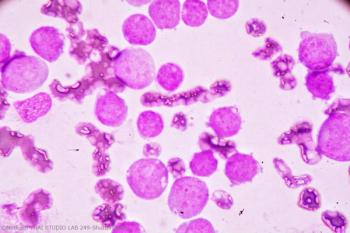
Preoperative pain, prothrombin time activity (PTA), albumin, urine protein, and postoperative chemotherapy appeared to be associated with prognosis.

Your AI-Trained Oncology Knowledge Connection!


Preoperative pain, prothrombin time activity (PTA), albumin, urine protein, and postoperative chemotherapy appeared to be associated with prognosis.

This study is the first to show significantly improved OS from single-agent treatment in this particularly difficult to treat population.

In CheckMate -078, nivolumab yielded superior OS compared with docetaxel in previously treated NSCLC, regardless of PD-L1 expression and tumor histology.

De-escalated treatment may be possible in patients with advanced HL who reach a metabolic response after only 2 cycles of escalated BEACOPP.

Efficacy of lenalidomide plus rituximab was similar to chemotherapy induction in previously untreated symptomatic FL, with a better safety profile.

In RCC patients on anti–PD-1 therapy, besides the indel count link to better OS, baseline tumor infiltration with M2 macrophages predicted improved PFS.

In the Utah Cancer Survivors Study, male thyroid cancer survivors had an almost 50% higher risk of developing cardiovascular disease than females.

The study is potentially a “leap forward” in cancer genomics, particularly for subsets of patients with metastatic and anaplastic thyroid cancer.

A multicenter, international phase II study found higher-dose and extended-dose therapy with Ra-223 did not improve survival or pain scores.

Polatuzumab vedotin administered with bendamustine and rituximab significantly improved PET-based CR rates, PFS, and OS in DLBCL but not FL.

The D-CARE study found adjuvant denosumab is devoid of benefits in high-risk early breast cancer.

A combination of irinotecan, cetuximab, and ramucirumab may boost PFS in advanced CRC, when given after failure of oxaliplatin-and-bevacizumab–based therapy.

Making some changes to the gut microbiome may improve outcomes with immune checkpoint inhibitors in renal cell carcinoma.

In the Italian RESORT trial, sorafenib did not affect recurrence-free survival in patients with mRCC following radical resection of metastases.

In TRANSCEND NHL 001, the CD19-directed 4-1BB CAR T-cell product lisocabtagene maraleucel yielded durable responses in heavily pretreated R/R DLBCL.

Pembrolizumab represents a new standard first-line treatment option for PD-L1–expressing advanced/metastatic NSCLC, according to KEYNOTE-042 investigators.

This approach may lead to better understanding of risk-mitigation strategies, and perhaps better outcomes in patients with secondary AML.

Unconventional strategies and targeted therapeutics may be required to overcome the adverse risks associated with TP53-mutated AML.

A California study showed women are significantly undertreated for head and neck cancer, with several factors possibly accounting for the disparity.

The use of geriatric assessment in routine care of older patients with advanced cancer may significantly improve doctor-patient communication.

Therapy with CAR T cells may benefit patients with highly refractory multiple myeloma, said U Penn’s Adam Cohen at ASCO 2018.

Risk stratification is leading to increasing numbers of new molecular targets in multiple myeloma.

In a CYCORE trial, mobile technology improved patient tracking, enabling clinicians to detect concerning symptoms early and respond quicker.

The approval should have a profound impact on patients with the rare tumor, according to experts.

Salvage cryoablation following local recurrence post radiation may be a safe way to avoid or delay initiation of hormone deprivation therapy.

A new analysis of PROSPER, presented at AUA 2018, suggests enzalutamide plus ADT may be superior to ADT alone in nonmetastatic CRPC.

A study led by Dr. Jun Mao of MSKCC found CBT and acupuncture each yielded clinically meaningful and durable sleep-related QOL improvements.

Recurrence risk was greater in sarcopenic patients, and greater alpha-fetoprotein and microvascular invasion were independent risk factors.

A Moffitt team suggests mathematical modeling may guide the optimal cancer treatment dosing approach better than MTD.

Certain genetic alterations associated with anaplastic transformation in thyroid cancer made patients sensitive to the multikinase inhibitor lenvatinib.